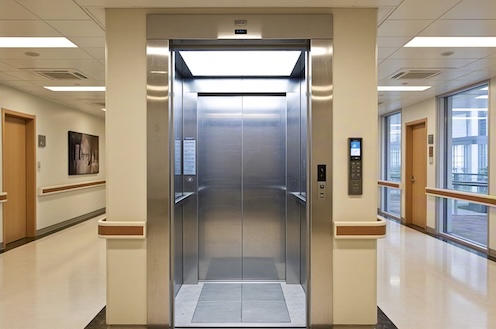In 2022, in the "Advanced Manufacturing Park" of the Ruhr Industrial Zone in Germany, Hans Müller, the logistics director of global industrial robot giant KUKA, stared at the piles of precision servo motors in the warehouse, with cold sweat oozing from his forehead. Over the past three months, these components worth tens of thousands of euros had frequently been damaged during elevator transportation, with the failure rate being five times the industry average. What was even more troublesome was that in the laboratory of the neighboring quantum computing startup NanoQ, a dilution refrigerator worth one million euros failed to start twice due to electromagnetic interference from the elevator, directly resulting in the loss of critical experimental data.

Hans broke the damaged motor casing at the industrial alliance meeting and bluntly stated, "The elevator is 'murdering' the precision equipment." A survey revealed that 60% of the enterprises in the park were troubled by elevator issues: medical equipment needed special escort, cell samples failed due to vibration, and the freight elevator malfunction caused the production line to be halted for 8 hours... The investment promotion department's report further pointed out that due to the outdated elevator configuration, the newly-built B Building for biomedicine was vacant at a rate of 45%, far exceeding the regional average.
The root cause of the problem lies in the cognitive mismatch. The undercover investigation conducted by the Fraunhofer Institute revealed:
Procurement inertia: 83% of enterprises still rely on the "load + speed + landing station" three-factor comparison method, without paying attention to key parameters such as vibration frequency and electromagnetic compatibility.
System isolation: The elevator control protocol is incompatible with the park's Internet of Things (IoT) system, and intelligent functions such as cargo flow prediction and energy optimization are ineffective.
Hidden costs: A certain automotive component manufacturer calculated that the loss of elevator downtime for one hour is equivalent to purchasing three new elevators.
"We use elevators like we use trucks," said Erin, the chief engineer of NanoQ, stroking the circuit board that was burned by electromagnetic interference. "Each time the elevator operates, the superconducting magnets of the quantum computer undergo a 'mini-earthquake'."
In the industrial sector, the hidden losses from elevator accidents are staggering: KUKA lost 500,000 euros worth of laser cladding heads due to an elevator emergency stop, resulting in a three-month delay in orders and losses exceeding one million euros; the cooling system of the quantum computing company NanoQ was disrupted by elevator electromagnetic interference, causing the experiments to lag behind the competitors by 18 months and leading to a financing crisis; in a top-tier hospital, the nuclear magnetic resonance equipment suffered from elevator radiation exceeding the standard, resulting in annual maintenance costs of over 2 million euros and a significant increase in patient waiting time. "Elevators are by no means ordinary transportation tools," said engineer Erin from NanoQ, pointing at the vibration data. "Vibrations exceeding 0.5 m/s²will sharply reduce the coherence time of quantum bits by 70%, similar to having a surgeon wearing a boxing glove to perform nanosurgery - in the era of precision manufacturing, elevators have become the 'operating room' in the vertical direction."
The turning point came in 2023 when the Siemens Building Technology team moved into the industrial park and implemented the "Vertical Efficiency Enhancement Plan":
Hardware renovation: Remove the old elevators and install intelligent carriages equipped with active vibration dampers, with the vibration acceleration controlled within 0.3 m/s²(close to the level of human heartbeat vibration); Install a nano-crystal soft magnetic alloy shielding layer on the inner wall of the shaft to reduce electromagnetic interference to the hospital operating room standard (≤10μT).
Software reconfiguration: Develop an elevator digital twin system that is linked in real time with KUKA's MES (Manufacturing Execution System); When the NanoQ quantum computer needs to be transported, the elevator automatically switches to "silent mode": suspend calls to other floors and adjust the operation curve to eliminate the risk of emergency stops.
Ecological collaboration: Establish a "Vertical Efficiency Alliance" consisting of elevator manufacturers, equipment suppliers, and logistics companies; Develop the "Industrial Elevator Technical Debt Assessment Guide", incorporating vibration, electromagnetic compatibility, etc. into the mandatory procurement standards.
After 12 months of renovation, the vertical transportation system in the industrial park underwent a dramatic transformation: KUKA's precision component transportation achieved zero damage, saving costs equivalent to that of two production lines; the NanoQ quantum computer operated stably for over 2,000 hours, catching up on 15 months of research progress; the vacancy rate in the park dropped sharply from 45% to 18%, and the rental premium was 12%, still in high demand; the energy consumption of the intelligent elevators decreased by 35%, and the carbon trading yielded 500,000 euros. "This is no longer a traditional elevator," the logistics director Hans pointed at the data flow in the control center. "AGV and quantum sample transportation demands are predicted in real time by the system, and the elevator coordinates the equipment in the shaft to avoid obstacles like a conductor."
This transformation spread rapidly: In 2024, the DIN mandated that industrial elevators be equipped with vibration spectrum analyzers. The market for intelligent elevators grew by 18% annually (with the industrial sector accounting for over 60%), and a paper from MIT in Science even stated outright that "elevator vibration control has become a more critical technical barrier than machine tool accuracy." Just as Siemens CTO Weber said at the Hannover Fair: "What we are reconfiguring is the vertical dimension of intelligent manufacturing infrastructure. When elevators start to think, the production rhythm of the entire factory changes accordingly."
